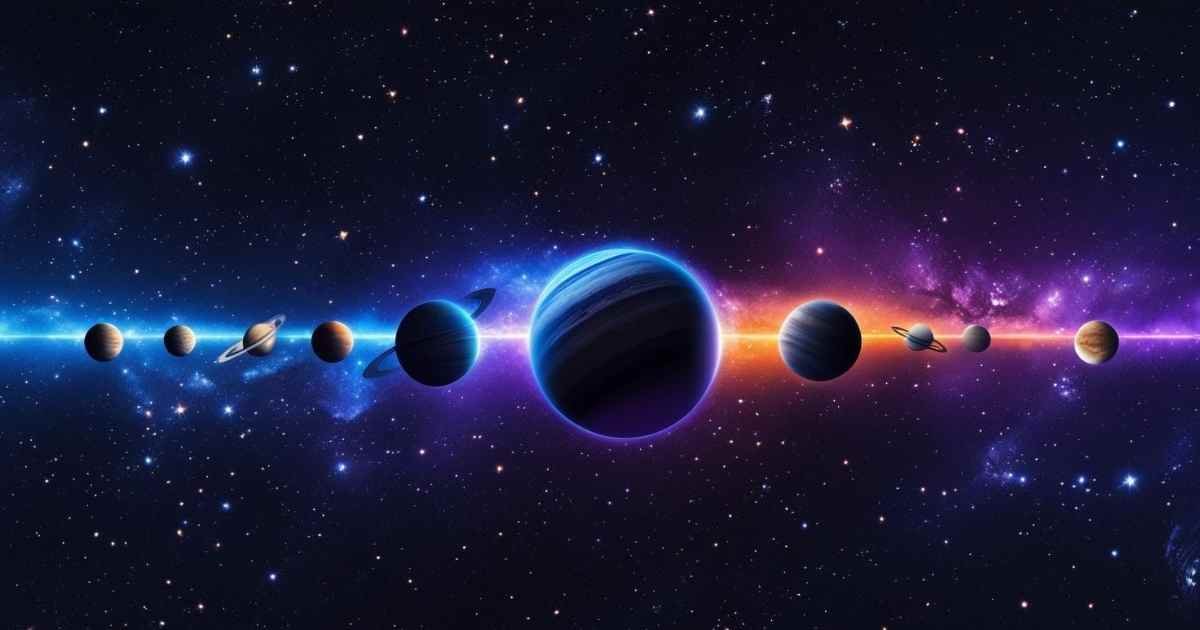Introduction – Why Planet Alignment 2025 Matters
There are nights when the sky feels ordinary, scattered with stars we’ve seen a thousand times. And then there are nights when the universe seems to put on a performance just for us. Planet Alignment 2025 will be one of those nights.
Imagine six planets—Mercury, Venus, Mars, Jupiter, Saturn, and Neptune—all appearing in a grand celestial row. It won’t be a perfect straight line in deep space, but from Earth, they’ll look as if they’re gathering for a rare cosmic parade.
Why does this matter? Because planetary alignments don’t just light up the sky; they ignite human imagination. For thousands of years, they’ve inspired myths, guided sailors, shaped philosophies, and pushed science forward. The 2025 alignment will remind us, once again, that we are part of a much bigger story.
What Is Planet Alignment?
Planet alignment is a perspective trick of the cosmos. The planets continue on their orbits, minding their own paths, but every so often, Earth gets the perfect angle to see several of them appear clustered in the same region of the sky.
It’s like standing on a street corner: cars on different lanes and speeds suddenly line up from your viewpoint. They aren’t actually together, but for a brief moment, your eyes see them in harmony.
Astronomers sometimes call this a planetary parade. And in 2025, we’re set to witness one of the most dazzling parades in decades. Some planets will glow brightly enough to be seen without equipment, while others may require binoculars or a telescope. Either way, the experience will be unforgettable.
The Origins – Humanity’s Fascination With Cosmic Patterns
Planet alignments have always been more than astronomy—they’ve been stories. Ancient people didn’t just look up; they read the skies like a book.
- Babylonians believed alignments carried messages for kings and harvests.
- The Maya linked planetary cycles to their calendar and rituals.
- In China, alignments were often recorded as omens for emperors.
- Greek philosophers, especially Pythagoras, saw harmony in the heavens as a reflection of universal order.
Even today, astrology draws heavily from these traditions, connecting alignments with personal destiny. Whether or not you believe in it, the fact remains: humans have always looked upward for meaning, and alignments are among the most powerful symbols of cosmic order.
Real-World Applications of Planet Alignment
At first glance, planetary alignment might look like a sky show for dreamers. But it has surprisingly practical impacts across many fields.
1. Astronomy and Space Science
When planets gather visually, scientists get unique observation angles. Alignments help refine our knowledge of orbits, atmospheres, and gravitational relationships. They also make it easier for educators to explain celestial mechanics to students.
2. Navigation and Technology
Long before satellites, sailors used the stars and planets to guide their ships. Today, modern astronomy continues to feed into GPS and space navigation, where planetary movements must be tracked with precision.
3. Society and Culture
Big celestial events bring people together. In 2025, observatories, stargazing camps, and online communities will unite people worldwide. For a few nights, everyone—from Tokyo to New York—will share the same view.
4. Education and Inspiration
Teachers love planetary alignments. They turn abstract concepts into real, visible experiences for students. A teenager staring at Mars and Saturn side by side might just become tomorrow’s space scientist.
5. Business and Tourism
Astro-tourism is growing fast. From desert sky lodges to mountaintop observatories, many businesses are already preparing for Planet Alignment 2025. People will travel long distances just to catch the perfect view.
How Planet Alignment Differs From Other Cosmic Events
The universe offers many shows: eclipses, meteor showers, comets. But alignments are different.
- An eclipse is a sudden shadow play, dramatic but brief.
- A meteor shower is fiery dust streaking through the atmosphere.
- A comet is a rare visitor leaving a glowing tail.
- A planetary alignment is slower, grander, and somehow more unifying.
If eclipses are drumbeats, alignments are symphonies. They stretch over nights, allowing people across the world to join in, without needing to be in one precise spot.
Future Implications – Beyond 2025
Planet Alignment 2025 is more than a date on a calendar. It hints at deeper possibilities for science and society.
1. Scientific Horizons
Researchers hope to use the alignment for better atmospheric readings and orbit refinements. It could even inspire discussions about sending future missions when planets line up for shorter travel paths.
2. Ethical and Cultural Reflections
Astrology gives alignments personal and mystical meaning. Science explains them with math and physics. Can both coexist? Many argue yes—myth gives meaning, while science gives truth. The debate itself keeps humanity curious.
3. Humanity’s Cosmic Future
Private companies are racing into space. With more people dreaming of Mars colonies and lunar bases, cosmic events like this alignment fuel the cultural imagination. It reminds us why space exploration matters in the first place.
Best Practices – How to Experience Planet Alignment 2025
You don’t need to be an astronomer to enjoy this event. Here’s how to make it unforgettable:
1. Escape the Lights
Find dark skies. Cities are filled with light pollution, so head to mountains, deserts, or countryside areas for a clear view.
2. Bring the Right Gear
While your eyes are enough, binoculars or a telescope will bring planets closer. Even smartphone astronomy apps can guide you.
3. Timing Is Everything
Some planets shine best at dusk, others near dawn. Check local charts to know when each will be visible.
4. Join Others
Astronomy clubs often hold viewing nights. Sharing the moment with others makes it even more memorable.
5. Reflect and Record
Don’t just snap photos—take a few minutes to think. What does it mean to see worlds aligning above you? Sometimes the sky is less about observation and more about perspective.
Planet Alignment in Culture, Literature, and Art
Beyond science, alignments have inspired art, music, and stories.
Painters of the Renaissance often placed planetary patterns in their work, symbolizing order. Writers like Shakespeare referred to “stars aligning” as fate. In modern times, films and novels still use planetary events as metaphors for destiny or cosmic turning points.
Planet Alignment 2025 will likely spark new poetry, photography, and documentaries. The cosmos has always been our greatest canvas.
Common Myths and Misconceptions
Whenever a planetary alignment occurs, myths follow.
- Some claim it will cause natural disasters—science proves otherwise.
- Others believe gravity from aligned planets could affect Earth—it’s too weak to matter.
- A popular myth is that alignments are once-in-a-lifetime. The truth: they happen fairly often, but not always with so many visible planets.
The reality is simple: alignments don’t change Earth physically, but they can change us—our sense of wonder, our unity, our imagination.
Global Viewing Guide for 2025
Where will you see it best? While the alignment will be visible worldwide, some locations promise clearer skies.
- Deserts like the Sahara or Atacama are perfect with minimal light pollution.
- Mountain ranges such as the Himalayas or Rockies offer higher altitudes for sharper views.
- Remote islands in the Pacific or Indian Ocean will have crystal-clear night skies.
- Rural regions worldwide, away from city glare, will still offer great views.
Travel companies are already offering “planet alignment tours” for 2025. Whether you’re in your backyard or halfway across the globe, the sky will be the same canvas.
Conclusion – A Cosmic Mirror for Humanity
When the planets align in 2025, it won’t just be an astronomical event—it will be a human one. People across continents will look up and see the same sight, reminding us that we all share the same sky.
In a world divided by borders, beliefs, and politics, the planets will silently demonstrate unity. They move on different paths, yet appear aligned. Perhaps there’s a lesson in that.
Planet Alignment 2025 is not about prediction or fate. It’s about wonder. And sometimes, wonder is enough to change how we see ourselves.
FAQs – Planet Alignment 2025 Simplified
Q1. What is Planet Alignment 2025?
It’s when six planets appear in a line in Earth’s sky, creating a rare visual spectacle.
Q2. Which planets will align in 2025?
Mercury, Venus, Mars, Jupiter, Saturn, and Neptune.
Q3. Can I see it without equipment?
Yes, most will be visible to the naked eye, but binoculars or a telescope will improve the view.
Q4. When will it happen?
Astronomers predict it will be most visible mid-2025, especially around summer nights.
Q5. Why is it important?
Because it combines science, culture, and human wonder, reminding us of our connection to the cosmos.











